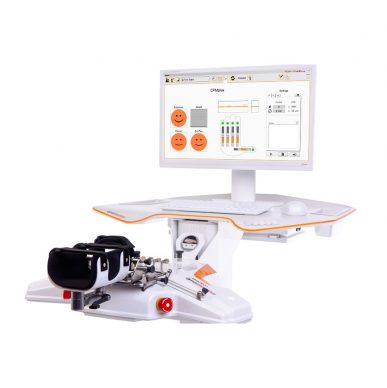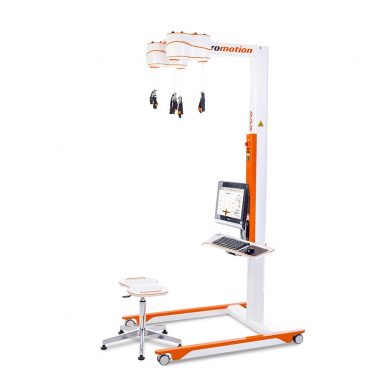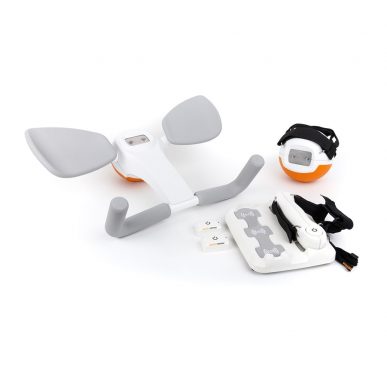














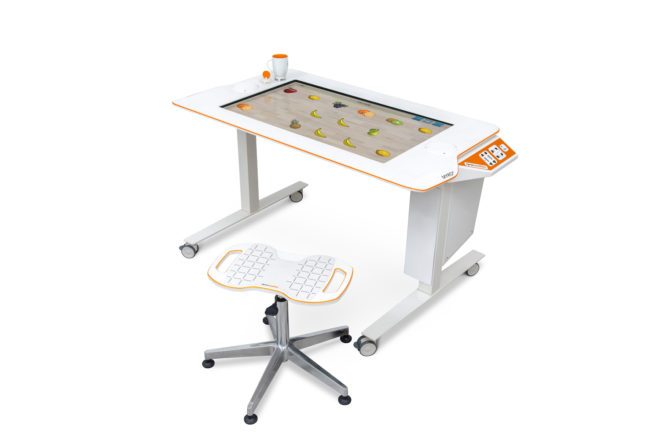

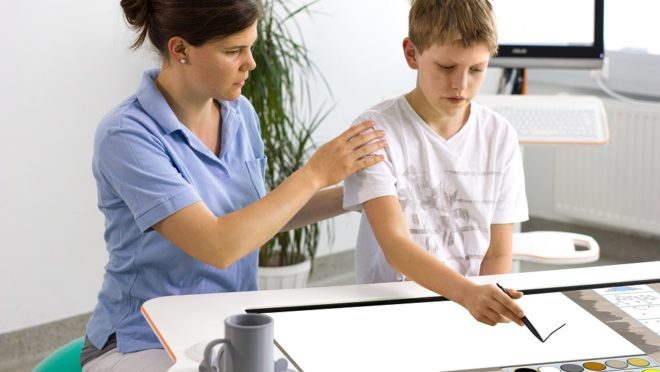

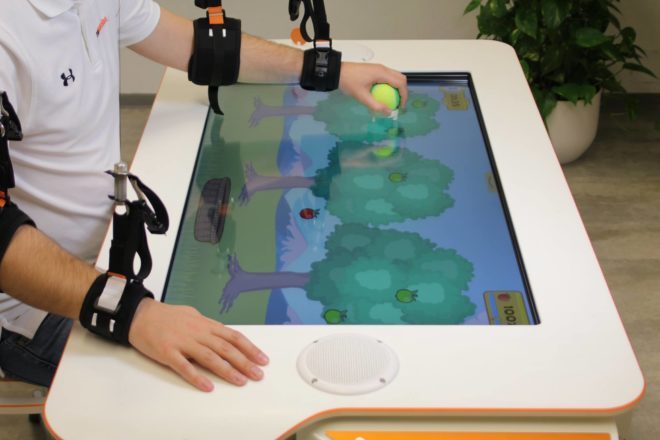

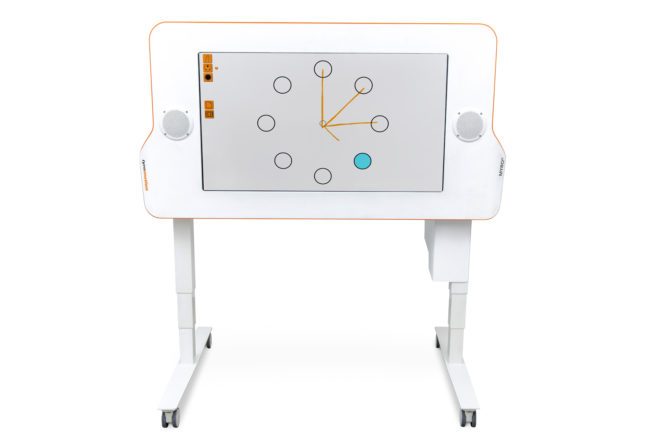

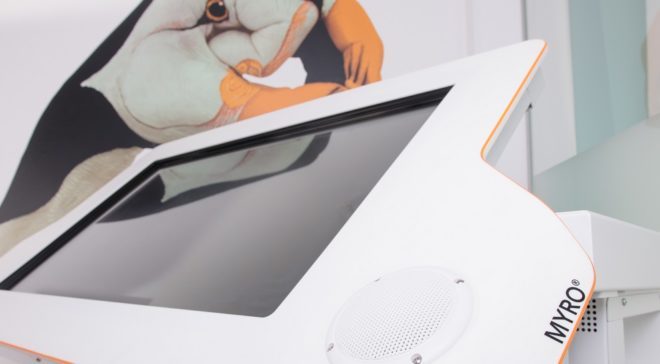

MYRO
Сповнений розноманіття, універсальності, інновації та креативу
Реальні предмети, контроль сили, завдання на дотик та багато веселощів: це те, з чого складається завдання-орієнтовна, інтуїтивна терапія з MYRO. Сенсорна поверхня є основою для креативної терапії, що приносить значущість та самовизначення у повсякденному житті. Когнітивні ігри MYRO змусять попотіти навіть терапевтів.
MYRO – це інтерактивна терапевтична поверхня, яка може використовуватися різними способами: сенсори MYRO створені для тренування моторних навичок щоденного життя за допомогою реальних об’єктів на чутливій поверхні. MYRO реагує не лише на рух, а й на тиск. Сеанси графомоторної терапії можуть бути реалізовані у гнучкий спосіб та без витратних матеріалів. Просторово-пошукові елементи створюють більше опцій для когнітивної терапії.
MYRO адаптується під потреби кожного пацієнта; горизонтально та вертикально: MYRO регулюється по висоті та робоча поверхня може нахилятися від 0 до 90 градусів. І навіть чутлива поверхня MYRO може бути відкалібрована під можливості пацієнта, що дозволяє тренування у межах своєї підготовки.
Факти про MYRO
- Дуже гнучкий у застосуванні
- Забезпечує робочій простір для більш ніж однієї особи
- Одно- та двостороннє тренування
- Може використовуватися у комбінації з DIEGO
- Проводить повне документування та відстеження терапії завдяки програмному забезпеченню TyroS
- Розпізнавання та відтворення форм
- Розпорядок дня та рутинні справи
- Візуальне дослідження
- Покращення точності рухів
- Підтримка креативності
- Допоміжна рухова терапія у комбінації з DIEGO
- Покращення моторних навичок та активного об’єму рухів
MYRO забезпечує ціле-орієнтовану реабілітацію з реальними об’єктами, тренує рухи повсякденного життя та покращує моторні навички пацієнта. MYRO також пропонує різноманіття нейрокогнітивних програм, які можна проходити в режимі одного або декількох гравців. Терапія з MYRO ніколи не буде нудною.
- Інтерактивні заняття з реальними предметами, завдання на контроль сили та натискання
- Неврологія, ортопедія, геріатрія та педіатрія
- Завдяння-орієнтована реабілітація з сенсорною поверхнею та реальними предметами
- Двостороння робота сприяє кращому “перепрограмуванню” півкуль
- Відстеження сили натискання та протягнення для оцінювання
- Тренування грубої моторики, дрібної моторики, обертальних рухів, координації рука-око, та моторної координації
- Корисно для пацієнтів з дефіцитом рухової функції, концентрації, селективної уваги, візуально-просторового сприйняття та просторово-сприйнятливої здатності
2018
Jakob I, Kollreider A, Germanotta M, Benetti F, Cruciani A, Padua L, Aprile I. PM&R, Volume 10, Issue 9, Supplement 2, S189-S197.
PubMed
2017
Bishop L, Gordon AM, Kim H.
American Journal of Physical Medicine & Rehabilitation. 2017 Jan;96(1):1-7. PubMed
Jakob I, Kollreider A, Grieshofer P, Kreuzig W, Vursic M, Petzold G.
Neurologie & Rehabilitation
Supplement 1; 2017
Hussain A, Balasubramanian S, Roach N, Klein J, Jarrasse N, Mace M, David A, Guy S, Burdet E. Journal of Rehabilitation and Assistive Technologies Engineering. 2017 Vol 4: 1–16.
PDF (en)
Mace M, Hussain A, Diane Playford E, Ward N, Balasubramanian S, Burdet E.VIEEE International Conference on Rehabilitation Robotics: [proceedings]. 2017:652-657.
PubMed
2016
Celadon N, Dosen S, Binder I, Ariano P, Farina D. Journal of Neuroengineering and Rehabilitation. 2016 Aug 4;13(1):73.
PubMed, Pdf (en)
Orihuela-Espina F, Femat Roldán G, Sánchez-Villavicencio I, Palafox L, Leder R, Enrique Sucar L, Hernández-Franco J.
Journal of Hand Therapy. 2016 Jan-Mar; 29(1):51-7.
PubMed
2014
Gharabaghi A, Naros G, Khademi F, Jesser J, Spüler M, Walter A, Bogdan M, Rosenstiel W, Birbaumer N.Frontiers in Behavioral Neuroscience. 2014 Dec; 8:429. Eberhard Karls University Tuebingen, Germany. University of Leipzig, Germany. IRCCS, Venice, Italy.
Pdf (en), PubMed
Gharabaghi A, Kraus D, Leão MT, Spüler M, Walter A, Bogdan M, Rosenstiel W, Naros G, Ziemann U.Frontiers in Human Neuroscience. 2014 Mar; 8:122. Eberhard Karls University Tuebingen, Germany. University of Leipzig, Germany.
PubMed
Vukelić M, Bauer R, Naros G, Naros I, Braun C, Gharabaghi A. Neuroimage. 2014 Feb; 87:147-53.
PubMed
Seitz RJ, Kammerzell A, Samartzi M, Jander S, Wojtecki L, Verschure P, Ram D. Int J Neurorehabilitation 2014. 1:113.
Department of Neurology, University Hospital Düsseldorf, Germany. SPECS Lab, Universitat Pompeu Fabra, Barcelona, Spain. Tyromotion, Graz, Austria.
Open Access Research Article
Hartwig M.
Neurologie & Rehabilitation. 2014(2): 111-116.
Pdf (de), Pdf (en)
Sale P, Mazzoleni S, Lombardi V, Galafate D, Massimiani MP, Posteraro F, Damiani C, Franceschini M.Int J Rehabil Res. 2014 Sep; 37(3):236-42. Department of Neurorehabilitation, IRCCS San Raffaele Pisana.BioRobotics Institute, Scuola Superiore Sant‘ Anna, Polo Sant‘ Anna Valdera, Pontedera. Rehabilitation Bioengineering Laboratory. Neurological Rehabilitation Unit, Auxilium Vitae Rehabilitation Center, Volterra eSan Raffaele Portuense, Rome, Italy.
PubMed
2013
Glatz AH, Madle R, Sattler J.Ergotherapie. 2013(4):25-29.SeneCura Neurologisches Rehabilitationszentrum Kittsee, Österreich.
Pdf (de)
Brailescu CM, Scarlet RG, Nica AS, Lascar I. Palestrica of third millennium – Civilization and Sport. Vol.14, no.4, October-December 2013, 263-270.Carol Davila University of General Medicine and Pharmacy, Bucharest, Romania. National Institute for Rehabilitation, Physical Medicine and Balneology Bucharest, Romania. Floreasca Emergency Hospital, Bucharest, Romania.
Pdf
2013
Pinter D, Pegritz S, Pargfrieder C, Reiter G, Wurm W, Gattringer T, Linderl-Madrutter R, Neuper C, Fazekas F, Grieshofer P, Enzinger C.Top Stroke Rehabil. 2013 Jul-Aug; 20(4):308-316.Departement of Neurology, Medical University of Graz, Austria.Division of Neuroradiology, Department of Radiology, Medical University Graz, Austria. Rehabilitation Clinic Judendorf-Strassengel, Austria.
PubMed
Borghese NA, Pirovano M, Lanzi PL, Wüest S, de Bruin ED. Games for Health Journal: Research, Development, and Clinical Application. Volume 2, Number 2, 2013. Department of Computer Science, University of Milan, Milan, Italy. Dipartimento di Elettronica, Informazione e Bioingegneria – Politecnico di Milano, Milan, Italy. Institute of Human Movement Sciences and Sport, Department of Health Sciences and Technology, ETH Zurich, Zurich, Switzerland.
Pdf, PubMed
Nica AS, Brailescu CM, Scarlet RG.. Stud Health Technol Inform. 2013:191:48-52. National Institute for Rehabilitation, Physical Medicine and Balneology Bucharest, Romania. Physical Medicine and Rehabilitation Department, Carol Davila University of General Medicine and Pharmacy, Bucharest, Romania.
PubMed, Pdf
Ortner R, Ram D, Kollreider A, Pitsch H, Wojtowicz J, Edlinger G. 15th International Conference on Human-Computer Interaction 2013.
Pdf
2012
Sale P, Lombardi V, Franceschini M.Stroke Res Treat. 2012:820931.Department of Neurorehabilitation, IRCCS San Raffaele Pisana, Rome, Italy.
PubMed, Pdf
Hwang CH, Seong JW, Son DS.Clin Rehabil. 2012 Aug; 26(8): 696–704. From the Department of Physical Medicine and Rehabilitation, Ulsan University Hospital, University of Ulsan College of Medicine, Ulsan, Republic of Korea.
PubMed
2011
Stein J, Bishop L, Gillen G, Helbok R.
Am J Phys Med Rehabil. 2011 Nov; 90(11):887-94. Department of Rehabilitation and Regenerative Medicine, Columbia University College of Physicians and Surgeons, New York. Clinical Department of Neurology, Innsbruck Medical University, Innsbruck, Austria.
PubMed
Kaiser V, Kreilinger A, Müller-Putz GR, Neuper C. Front Neurosci. 2011 Jul 5;5:86. Laboratory of Brain-Computer Interfaces, Institute for Knowledge Discovery, Graz University of Technology, Austria. Department of Psychology, University of Graz, Austria.
PubMed, Pdf
Hartwig M. Neurologie & Rehabilitation. 2011(1):42–46.
Pdf (de), Pdf (en)
Stein J, Bishop L, Gillen G, Helbok R.IEEE Int Conf Rehabil Robot. 2011:5975426. Department of Rehabilitation and Regenerative Medicine, Columbia University College of Physicians and Surgeons, New York. Clinical Department of Neurology, Innsbruck Medical University, Innsbruck, Austria.
PubMed
2010
Helbok R, Schoenherr G, Spiegel M, Sojer M, Brenneis C.Clinical Department of Neurology, Neurological Intensive Care Unit, Medical University Innsbruck, Austria. Mayr A, Kollreider A, Ram D, Saltuari L. Hospital Hochzirl, Department of Neurology, Austria. Research Department for Neurorehabilitation, Bolzano, Italy. Tyromotion, Graz, Austria.











